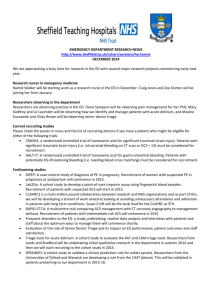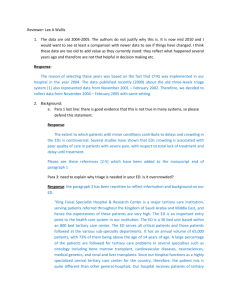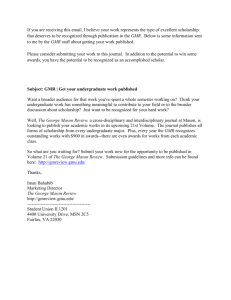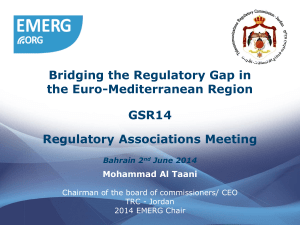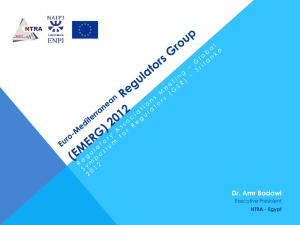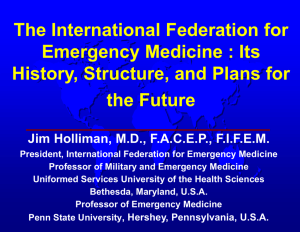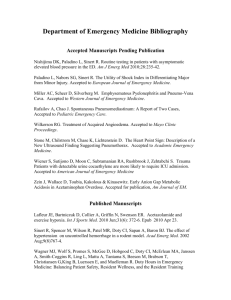RESEARCH NEWS - Sheffield Clinical Research
advertisement
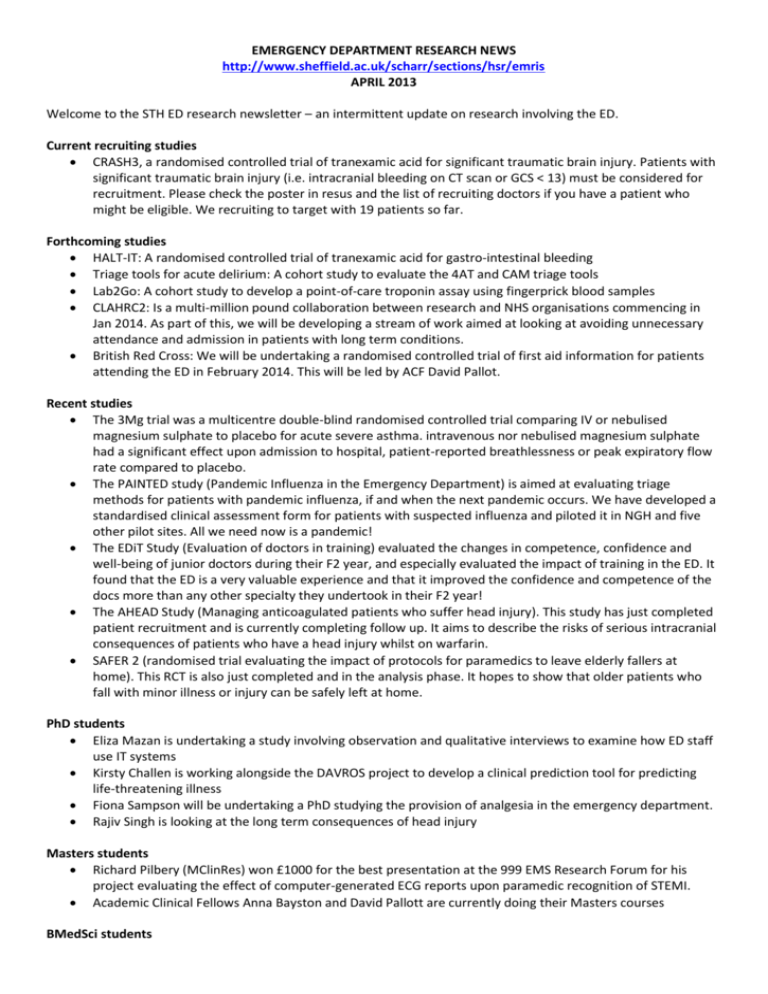
EMERGENCY DEPARTMENT RESEARCH NEWS http://www.sheffield.ac.uk/scharr/sections/hsr/emris APRIL 2013 Welcome to the STH ED research newsletter – an intermittent update on research involving the ED. Current recruiting studies CRASH3, a randomised controlled trial of tranexamic acid for significant traumatic brain injury. Patients with significant traumatic brain injury (i.e. intracranial bleeding on CT scan or GCS < 13) must be considered for recruitment. Please check the poster in resus and the list of recruiting doctors if you have a patient who might be eligible. We recruiting to target with 19 patients so far. Forthcoming studies HALT-IT: A randomised controlled trial of tranexamic acid for gastro-intestinal bleeding Triage tools for acute delirium: A cohort study to evaluate the 4AT and CAM triage tools Lab2Go: A cohort study to develop a point-of-care troponin assay using fingerprick blood samples CLAHRC2: Is a multi-million pound collaboration between research and NHS organisations commencing in Jan 2014. As part of this, we will be developing a stream of work aimed at looking at avoiding unnecessary attendance and admission in patients with long term conditions. British Red Cross: We will be undertaking a randomised controlled trial of first aid information for patients attending the ED in February 2014. This will be led by ACF David Pallot. Recent studies The 3Mg trial was a multicentre double-blind randomised controlled trial comparing IV or nebulised magnesium sulphate to placebo for acute severe asthma. intravenous nor nebulised magnesium sulphate had a significant effect upon admission to hospital, patient-reported breathlessness or peak expiratory flow rate compared to placebo. The PAINTED study (Pandemic Influenza in the Emergency Department) is aimed at evaluating triage methods for patients with pandemic influenza, if and when the next pandemic occurs. We have developed a standardised clinical assessment form for patients with suspected influenza and piloted it in NGH and five other pilot sites. All we need now is a pandemic! The EDiT Study (Evaluation of doctors in training) evaluated the changes in competence, confidence and well-being of junior doctors during their F2 year, and especially evaluated the impact of training in the ED. It found that the ED is a very valuable experience and that it improved the confidence and competence of the docs more than any other specialty they undertook in their F2 year! The AHEAD Study (Managing anticoagulated patients who suffer head injury). This study has just completed patient recruitment and is currently completing follow up. It aims to describe the risks of serious intracranial consequences of patients who have a head injury whilst on warfarin. SAFER 2 (randomised trial evaluating the impact of protocols for paramedics to leave elderly fallers at home). This RCT is also just completed and in the analysis phase. It hopes to show that older patients who fall with minor illness or injury can be safely left at home. PhD students Eliza Mazan is undertaking a study involving observation and qualitative interviews to examine how ED staff use IT systems Kirsty Challen is working alongside the DAVROS project to develop a clinical prediction tool for predicting life-threatening illness Fiona Sampson will be undertaking a PhD studying the provision of analgesia in the emergency department. Rajiv Singh is looking at the long term consequences of head injury Masters students Richard Pilbery (MClinRes) won £1000 for the best presentation at the 999 EMS Research Forum for his project evaluating the effect of computer-generated ECG reports upon paramedic recognition of STEMI. Academic Clinical Fellows Anna Bayston and David Pallott are currently doing their Masters courses BMedSci students Jospeh Buckley is undertaking a BMedSci involving interviewing patients who have recently suffered a medical emergency to explore their attitudes towards participation in emergency medicine clinical trials Chris Hooper, Rowena Johnson and Charlotte Walker-Jones will all be undertaking BMedSci studies on various EM topics ranging from the investigation of abdominal pain to how we recruit patient to EM research. Erin Whyte, Tom Bidmead and Amy Hewitt successfully completed their BMedSci projects Masters in Advanced Emergency Care This advanced Masters course is aimed at clinicians with experience in emergency medicine. It is mainly delivered as a distance learning course, and aims to improve clinical, research and leadership skills in the specialty. For further information visit: http://www.sheffield.ac.uk/scharr/prospective_students/masters/ace/course Research Contacts Clinical Research Coordinator: Martin Collins, 0114 22 68475 or martin.collins@sth.nhs.uk Research Nurse Support: Rachel Walker, 15375 and 07791 380717 or Rachel.Walker@sth.nhs.uk Selected recent publications 1. O’Cathain A, Knowles E, Maheswaran R, Pearson T, Turner J, Hirst E, Goodacre S, Nicholl J. A system-wide approach to explaining variation in potentially avoidable emergency admissions: national ecological study. BMJ Quality and Safety 2014;23:47-55 2. Than M, Aldous S, Lord SJ, Goodacre S, Frampton CMA, Troughton R et al. A 2-Hour Diagnostic Protocol for Possible Cardiac Chest Pain in the Emergency Department: A Randomized Clinical Trial. JAMA Intern Med 2014;174(1):51-8. 3. Whiteley J, Goodacre S. Patient expectations of minor injury care: A cross-sectional survey. Emerg Med J 2013; doi:10.1136 4. Hargreaves K, Goodacre S, Mortimer P. Paramedic perceptions of the feasibility and practicalities of prehospital clinical trials: A questionnaire survey. Emerg Med J 2013; doi:10.1136 5. Mason S, Weber EJ, Coster J, Freeman J, Locker T. Time patients spend in the emergency department: England's 4-hour rule-a case of hitting the target but missing the point? Ann Emerg Med. 2012 May;59(5):341-9 6. Rogenstein C, Kelly AM, Mason S, Schneider S, Lang E, Clement CM, Stiell IG.An international view of how recent-onset atrial fibrillation is treated in the emergency department. Acad Emerg Med. 2012 Nov;19(11):1255-60. 7. Weber EJ, Mason S, Carter A, Hew RL. Emptying the corridors of shame: organizational lessons from England's 4-hour emergency throughput target. Ann Emerg Med. 2011 Feb;57(2):79-88. 8. Lecky, F. E., Mason, S., Benger, J., Cameron, P., & Walsh, C. (n.d.). IFEM Framework for Quality and Safety in the Emergency Department.: IFEM Framework for Quality and Safety in the Emergency Department.. International Federation for Emergency Medicine. Retrieved from http://www.ifem.cc/Resources/PoliciesandGuidelines.aspx 9. Knowles, E., Mason, S. M., & Moriarty, F. (2012). 'I'm going to learn how to run quick': exploring violence directed towards staff in the Emergency Department. Emerg Med J. doi:10.1136/emermed-2012-201329 10. Nicholl J, Mason S. Return of the ‘corridors of shame’? BMJ. 2013 Jul 8;347:f4343. doi: 10.1136/bmj.f4343. Apologies to anyone whose research is missing from this newsletter. If you want to add or correct anything please contact Steve Goodacre (s.goodacre@sheffield.ac.uk) or Jill Bishop (jill.bishop@sth.nhs.uk)
